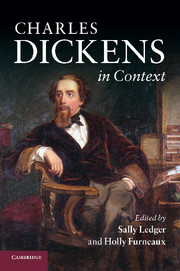Book contents
- Frontmatter
- Contents
- List of illustrations
- Notes on contributors
- Preface
- Notes on references
- PART I LIFE AND AFTERLIFE
- PART II SOCIAL AND CULTURAL CONTEXTS
- 12 Popular culture
- 13 The rise of celebrity culture
- 14 The newspaper and periodical market
- 15 Authorship and the professional writer
- 16 The theatre
- 17 Melodrama
- 18 The Bildungsroman
- 19 Visual culture
- 20 The historical novel
- 21 The illustrated novel
- 22 Christmas
- 23 Childhood
- 24 Work
- 25 Europe
- 26 The Victorians and America
- 27 Educating the Victorians
- 28 London
- 29 Politics
- 30 Political economy
- 31 The aristocracy
- 32 The middle classes
- 33 Urban migration and mobility
- 34 Financial markets and the banking system
- 35 Empires and colonies
- 36 Race
- 37 Crime
- 38 The law
- 39 Religion
- 40 Science
- 41 Transport
- 42 Illness, disease and social hygiene
- 43 Domesticity
- 44 Sexuality
- 45 Gender identities
- Further reading
- Index
- References
19 - Visual culture
Published online by Cambridge University Press: 05 August 2012
- Frontmatter
- Contents
- List of illustrations
- Notes on contributors
- Preface
- Notes on references
- PART I LIFE AND AFTERLIFE
- PART II SOCIAL AND CULTURAL CONTEXTS
- 12 Popular culture
- 13 The rise of celebrity culture
- 14 The newspaper and periodical market
- 15 Authorship and the professional writer
- 16 The theatre
- 17 Melodrama
- 18 The Bildungsroman
- 19 Visual culture
- 20 The historical novel
- 21 The illustrated novel
- 22 Christmas
- 23 Childhood
- 24 Work
- 25 Europe
- 26 The Victorians and America
- 27 Educating the Victorians
- 28 London
- 29 Politics
- 30 Political economy
- 31 The aristocracy
- 32 The middle classes
- 33 Urban migration and mobility
- 34 Financial markets and the banking system
- 35 Empires and colonies
- 36 Race
- 37 Crime
- 38 The law
- 39 Religion
- 40 Science
- 41 Transport
- 42 Illness, disease and social hygiene
- 43 Domesticity
- 44 Sexuality
- 45 Gender identities
- Further reading
- Index
- References
Summary
Visual materials proliferated during Dickens's lifetime. During the nineteenth century technological innovation enabled easier and cheaper reproduction and dissemination of woodcuts, engravings, chromolithographs and other forms of illustration, whether circulating within books or periodicals or as free-standing prints – as with the Galaxy Gallery of British Beauty with which Weevle decorates the bare walls of his lodgings in Bleak House. The satiric magazine Punch, which carried many topical cartoons, first appeared in 1841, the Illustrated London News in 1842, and its main rival, the Graphic, in 1869. Advances in technology, too, allowed for the production of advertisements that were pasted on available walls and hoardings in urban centres. The production of daguerreotypes and photographs from 1839 onwards allowed people to possess images of themselves and others, and of places both familiar and strange, that had, as if by magic, been created by capturing the light that fell on the thing itself.
Photography was just one technique of visual memorialising: this was the age, too, of the souvenir and of such personal tools of recollection as jewellery made of hair, as well as of a considerable growth in public commemorative pieces (the Albert Memorial, the most startlingly elaborate of these, opened two years after Dickens's death). In turn, this private and civic consumption of art reflected the amount of capital in circulation that could be turned to the purchase and commission of original art. Importantly, this period saw a major shift in the system of artistic patronage.
- Type
- Chapter
- Information
- Charles Dickens in Context , pp. 148 - 157Publisher: Cambridge University PressPrint publication year: 2011
References
- 1
- Cited by



